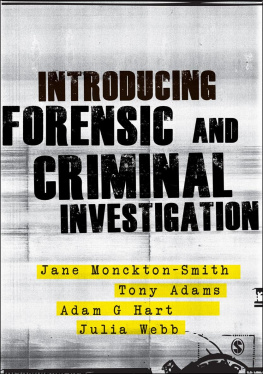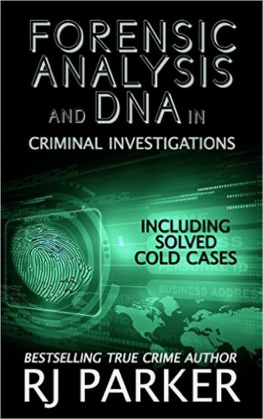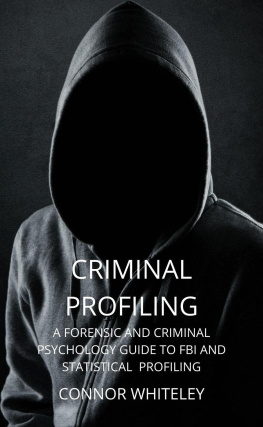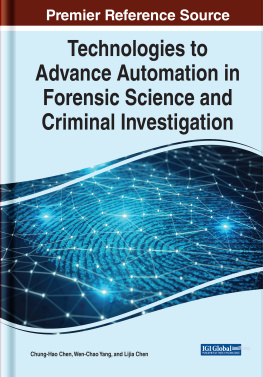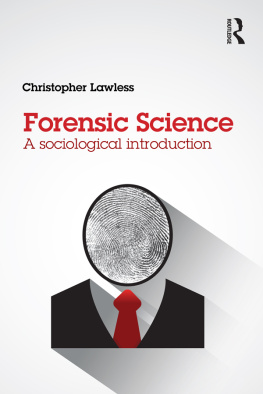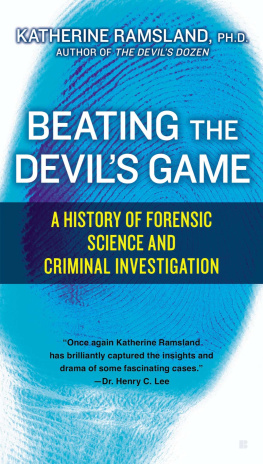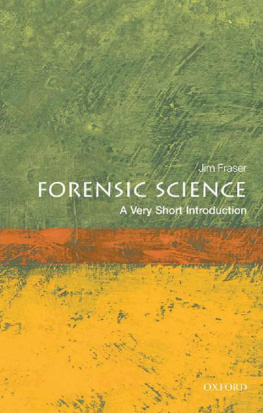CRIMINAL
JUSTICE
AND
FORENSIC
SCIENCE

Lisa Smith and John Bond 2015
All rights reserved. No reproduction, copy or transmission of this publication may be made without written permission.
No portion of this publication may be reproduced, copied or transmitted save with written permission or in accordance with the provisions of the Copyright, Designs and Patents Act 1988, or under the terms of any licence permitting limited copying issued by the Copyright Licensing Agency, Saffron House, 610 Kirby Street, London EC1N 8TS.
Any person who does any unauthorized act in relation to this publication may be liable to criminal prosecution and civil claims for damages.
The authors have asserted their rights to be identified as the authors of this work in accordance with the Copyright, Designs and Patents Act 1988.
First published 2015 by
PALGRAVE
Palgrave in the UK is an imprint of Macmillan Publishers Limited, registered in England, company number 785998, 4 Crinan Street, London N1 9XW.
Palgrave Macmillan in the US is a division of St Martins Press LLC, 175 Fifth Avenue, New York, NY 10010.
Palgrave is a global imprint of the above companies and is represented throughout the world.
Palgrave and Macmillan are registered trademarks in the United States, the United Kingdom, Europe and other countries
ISBN: 9781137310255 paperback
This book is printed on paper suitable for recycling and made from fully managed and sustained forest sources. Logging, pulping and manufacturing processes are expected to conform to the environmental regulations of the country of origin.
A catalogue record for this book is available from the British Library.
A catalog record for this book is available from the Library of Congress.
Printed in China
LIST OF FIGURES
FOREWORD
Andrew Rennison, former UK Forensic Science Regulator
Forensic science has the unique ability to attract public, legal and academic curiosity and interest that is not diminished over time or subject by fashionable ebbs and flows. Having spent the last six years working across all aspects of forensic science I can see, and fully understand, how and why people across the board cannot help but be fascinated by the use of science in the hunt for clues.
This book provides an effective platform for students and other interested readers who may not have a background in science or forensic science, and will give them an informed and illustrated insight into the modern world of science used in the investigation of crimes. It demystifies some of the mysteries of forensic science, from the early stages during the search for evidence at a crime scene, through to the presentation of opinions by experts in the courtroom. The authors quite properly point out some of the imperfections and steer readers away from the glamorised fictional world that sometimes portrays science as operating without any flaws or misconceptions.
The use of case studies throughout the chapters provides valuable insights into the real world of forensic science, underpinned by some straightforward and easy-to-grasp text. Readers will quickly understand that the term forensic science is commonly used nowadays as a noun encompassing a wide range of scientific methods, many of which cannot be covered in a book of this nature. However, those aspects of forensic science that are included are highly relevant and form the bulk of everyday work by forensic practitioners, who have to operate within the context of a criminal justice system that sets justifiably high expectations. Every chapter in this book is relevant to the work I do in regulating the quality standards that should apply to all aspects of forensic science. The authors are able to provide considerable practical, research and teaching experience to provide fresh insights into this captivating subject.
A MULTIDISCIPLINARY APPROACH TO FORENSIC STUDIES
A recent history of forensic science
Although there are early examples of using some form of physical evidence found at a crime scene to provide a link to a possible offender (Kind and Overman, 1972), it was in the nineteenth century that the use of scientific techniques to assist the police in solving crime became well established. Invariably, this early use of science was to assist in the police investigation of violent crime and it was from a bloodstained fingerprint that Juan Vucetich, an Argentinean police official, provided the first positive identification to an offender in 1892 (Beavan, 2002). Vucetich also founded the first Fingerprint Identification Bureau (also in Argentina), building on the work of Sir Francis Galton, Henry Faulds and others in the UK who had, some years earlier, suggested the use of fingerprints as a means of identifying offenders and solving crime (Beavan, 2002).
As we will see in when we examine different comparison evidence types in detail.
By the second half of the twentieth century, the term forensics (from the latin forensis, relating to Roman legal proceedings) or forensic science became synonymous with the use of science in a legal or courtroom context to assist in solving crime, with dedicated staff employed by police forces to search for and recover evidence of forensic interest from crime scenes. Coupled with this was the establishment of dedicated laboratories to process forensic material and to make comparisons between the material recovered from a crime scene and that from a suspect, across a range of disciplines. Possibly the first dedicated forensic laboratory was that set up in 1910 in Lyon, France by Edmond Locard. In the UK, forensic examinations were increasingly being performed in small, locally run laboratories and, by the 1930s, some of these laboratories were transferred to government control to form what eventually became the UK Forensic Science Service (FSS). By the 1960s there were nine specialist forensic laboratories in England and Wales.
In the USA, the Director of the Federal Bureau of Investigation (J. Edgar Hoover) and experts such as Calvin Goddard were instrumental in setting up the Bureaus Scientific Crime Detection Laboratory in 1932. However, the vast majority of forensic evidence was (and still is) processed in government (public) laboratories organised at city, county or state level. By the end of the twentieth century, there were approximately 400 laboratories operating in the USA (Johns and Kahn, 2004). The first laboratory to be established in North America was, however, in Montreal, Canada by Wilfred Drme in 1914, with the Royal Canadian Mounted Police opening their own forensic laboratory in Regina, Saskatchewan in 1937. Current issues related to the organisation and finance of forensic science laboratories are considered in .
In the 1980s, a major advance in forensic science was made with the discovery by Alec Jeffreys (at the University of Leicester, UK) that the make-up of the DNA (deoxyribonucleic acid) molecule could be used to distinguish between individuals. Jeffreys realised that human DNA could produce consistent, unique patterns and that these could be used not only to identify individuals, but also to indicate familial relationships. The first legal case to use this new technique was an immigration case, which hinged on proving whether a woman and a young boy were mother/son or aunt/nephew. A paternity case followed shortly thereafter and for two years Jeffreys university laboratory in Leicester was the only place in the world offering this kind of service. The attention of the police was drawn to this new technology and a double murder case from the mid-1980s was solved by Jeffreys showing that DNA recovered from both murder scenes was consistent with the DNA of an individual who was not otherwise obviously associated with the murders. This discovery has ultimately led to the biggest advance in identification forensic evidence since the work of Vucetich and others with fingerprints in the late nineteenth century.




